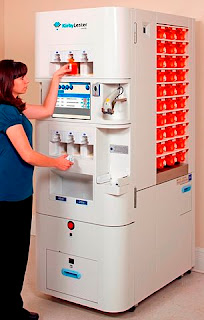Increasing
incidence of deaths and injuries due to medication prescription error
is consistently putting pressure on healthcare providers and
pharmacists to deploy more effective technologies. Also, the
medication distribution system is becoming more and more complex with
the rising number of patient visits along with the pressure of
ensuring their safety needs. Advanced automated technologies and
solutions are emerging as the most effective tools to reduce
medication errors and improve patient safety. Installing automated
systems also helps pharmacists and healthcare providers to lower
pharmacy costs.
Automation
is available for functions such as tablet counting, compound
preparation, prescription management, medication packaging,
dispensing and inventory management. The full benefits of each system
may be realized when several technologies are integrated together.
The pharmacy automation market is expected to grow due to mounting
pressure to reduce medication errors, increasing number of doses
given to patients, escalating healthcare expenditure and time
efficiency provided by these technologies. The demand for these
technologies is also expected to increase with reducing medical
reimbursement and rising drug prices which are predicted to put
pressure on healthcare providers to reduce their overall pharmacy
costs. Stringent government regulations regarding packaging, labeling
and drug compounding are also accelerating the demand for automated
packaging and labeling and compounding technologies. However, high
cost of implementation is the major challenge for the growth of these
technologies. Vendors will find large opportunity in this market by
developing cost effective technologies for small and mid-sized
hospitals and pharmacies.
Error
in medication prescription dispensing is a leading cause of death in
North America after cancer, heart and strokes. About 10,000 people
die per year in Canada and around 100,000 deaths and more than two
million injuries are estimated in the U.S due to medication errors.
Medication errors also increase the cost for healthcare providers and
patients. It is found that about 70% of these medication errors are
preventable and healthcare providers along with pharmacists in these
regions are investing in automated technologies which enable them to
reduce these errors and improve patient safety. North America is the
largest regional market for pharmacy automation systems followed by
Europe and is expected to maintain its position through the forecast
period from 2012 to 2018. In developed markets such as Canada, the
U.S and EU5 countries, there is a large potential for replacement
market as healthcare providers in these countries are striving for
advanced technologies to replace existing pharmacy automation. ”Rest
of The World” region represents the fastest growing region in this
market and the demand for these technologies is expected to increase
with rising awareness and investment in healthcare infrastructure in
Middle-East.
Know
the Importance for Pharmacy Automation Systems:
http://bit.ly/2bEY2C5
Several
operations in industries are now partially or fully automated, and
pharmacies are no exception. The integration of several different
technologies for automating pharmacy operations is a defining trend
in the pharmacy automation systems market. In recent years, processes
and operations that have been automated include: compound
preparation, tablet counting, dispensing and inventory management,
medical packaging, and prescription management. Many different
machines are used for this purpose. Some of the advantages of
pharmacy automation systems include the ability to stock the right
quantity of medication at the specified location, dispensing the
right dosage of medicine, and to increase the overall efficiency of a
pharmacy while keeping costs low. The trend of e-prescribing is
aiding the growth of the global pharmacy automation systems market.
The
recent developments reported by major companies in the global
pharmacy automation systems market are analyzed in the report.
Companies that have been profiled include: CareFusion Corporation,
McKesson Corporation, AmerisourceBergen Corporation, Cerner
Corporation, Omnicell Inc, Health Robotics SRL, Yuyama Co., Ltd, and
others. These players operate in a fragmented market and the degree
of competition varies from one sector to another.

No comments:
Post a Comment